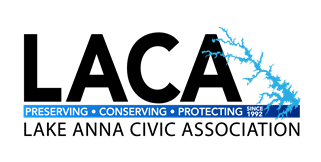By Joe Bailey – February 2025
If you are like me, you sometimes lose faith in the ability of federal, state and local government agencies and organizations to collaborate in meaningful ways to make measurable improvements to things that really matter. I’m writing this article to let you know that it actually does happen!
The U.S. Geological Survey (USGS), in partnership with the Virginia Department of Environmental Quality (DEQ), the Lake Anna Civic Association (LACA) and the Lake Anna Advisory Committee (LAAC), Old Dominion University (ODU) and Virginia Commonwealth University (VCU), is actively investigating the causes and dynamics of harmful algal blooms (HABs) in Lake Anna, Virginia. Since 2018, Lake Anna has experienced recurring HABs during the mid-summer months, leading to advisories from the Virginia Department of Health that recommend avoiding recreational activities in affected areas.
The joint study focuses on continuous and discrete monitoring of hydrology, water quality, and weather conditions in two tributaries and various locations along Lake Anna. By analyzing these factors, researchers aim to understand the initiation, persistence, and decline of HABs. The objectives include identifying the primary sources contributing to HAB formation and developing predictive tools for early detection.
This collaborative effort seeks to enhance water quality management strategies for Lake Anna, ensuring the safety and enjoyment of this popular recreational destination.
The success of these monitoring efforts often relies on the cooperation of local residents and community organizations. LACA, for instance, has a history of collaborating with governmental agencies to monitor and maintain the lake's water quality. Their involvement includes facilitating access to various parts of the lake for data collection purposes. For this project, three LACA members provided continuous access to their docks for an 18-month period. Such partnerships are crucial for comprehensive environmental monitoring and the development of effective water quality management strategies. These monitoring stations are strategically placed to collect data that aids in understanding and managing the water quality of Lake Anna.
LACA continues to play a pivotal role in monitoring and preserving the water quality of Lake Anna. Established in 2002, LACA's Volunteer Water Quality Monitoring Program collaborates with the Virginia Department of Environmental Quality (DEQ) to assess various parameters, including E.coli bacteria levels, acidity, dissolved oxygen, nutrients, and water clarity. Monitoring is conducted at over 30 sites under a Memorandum of Agreement with DEQ.
LACA's extensive data collection and analysis support the U.S. Geological Survey (USGS) and DEQ in their studies to understand the drivers of HABs in Lake Anna. This collaborative approach enhances water quality management strategies, ensuring the lake remains a safe and enjoyable resource for all.
As the extensive amount of data collected is analyzed in the coming months, the findings will be instrumental in identifying patterns and potential causes of HABs, thereby aiding in the development of effective mitigation strategies. The USGS, DEQ and LACA continue to analyze this data to enhance water quality management and ensure the safety of Lake Anna's recreational waters.
Seeing federal, state and local agencies and organizations working so closely together toward a common goal that is important to me has renewed my faith in the power of collaboration.
joe.bailey@lakeannavirginia.org
